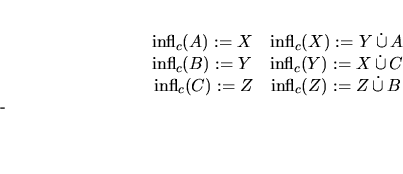Next: Robert Dawson - What Up: Discrete Geometry / Géométrie Previous: Balázs Csikós - Some
Ludwig Danzer and Gerrit van Ophuysen - A species of planar triangular tilings with inflation
factor

| LUDWIG DANZER AND GERRIT VAN OPHUYSEN, Universität Dortmund, Facherbereich Mathematik, Lehrstuhl II, 44221 Dortmund, Germany |
| A species of planar triangular tilings with inflation
factor
|
Consider the set
![]() of two right triangles in
of two right triangles in ![]() with sides having squared lengths 1,
with sides having squared lengths 1, ![]() ,
, ![]() and
and
![]() ,
, ![]() ,
,
![]() respectively. These can be glued
together (in only one way) to form a third right triangle
respectively. These can be glued
together (in only one way) to form a third right triangle
![]() with sides of squared length
with sides of squared length ![]() ,
,
![]() ,
,
![]() . We then consider the inflation rule
infl(A):=X,
. We then consider the inflation rule
infl(A):=X,
![]() . Interpreting
. Interpreting ![]() as
as ![]() the
inflation factor
the
inflation factor ![]() becomes
becomes
![]() which is a complex
Pisot-number. The species
which is a complex
Pisot-number. The species
![]() of all global
of all global
![]() -tilings created by
-tilings created by
![]() has a unique deflation
(``
infl-1'') and hence is aperiodic. The set of all vertices
can
be shown to be a ``model set'' (Robert Moody), so the
Fourier-transformation of the autocorrelation function is ``pure
point'' with the Bragg-peaks located on the
has a unique deflation
(``
infl-1'') and hence is aperiodic. The set of all vertices
can
be shown to be a ``model set'' (Robert Moody), so the
Fourier-transformation of the autocorrelation function is ``pure
point'' with the Bragg-peaks located on the ![]() -module
-module
 .
.
With
![]() , where B and C are
congruent to A, while Y and Z are congruent to X, but all
differently coloured, and
, where B and C are
congruent to A, while Y and Z are congruent to X, but all
differently coloured, and

we receive the species
Next: Robert Dawson - What Up: Discrete Geometry / Géométrie Previous: Balázs Csikós - Some

